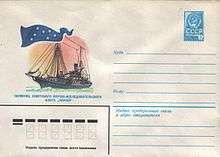Perseus (Soviet ship)
 1979 Soviet illustrated postal envelope showing the Perseus and its banner | |
| History | |
|---|---|
| USSR | |
| Completed: | 1922 |
| Maiden voyage: | 1923 |
| In service: | 1922 |
| Out of service: | 1941 |
| General characteristics | |
| Type: | Research vessel |
| Displacement: | 550 tons |
| Length: | 41.5 metres (136 ft) |
| Beam: | 8 metres (26 ft) |
| Draft: | 3.2 metres (10 ft) |
| Installed power: | 360 hp |
| Propulsion: | triple expansion steam engine |
| Speed: | 7.5 knots |
| Crew: | 24, of which 16 expedition members |
Perseus (Russian: Персей) was the first Soviet research ship. (It was not the first Russian research ship, that being the Imperial Russian ship Saint Andrew, which undertook expeditions under the direction of fisheries research pioneer Nikolai Knipovich (and later L. L. Breytfus) from 1899 to 1907.)
Perseus was constructed as a sealer (seal hunting ship) by industrialist E. V. Mogučim at Onega, Russia on the White Sea in 1916. In 1919 (political conditions and thus ownership having changed) it was towed to Archangel where on January 10 of 1922 the Council of Labor and Defense transferred it to PINRO (Russian: ПИНРО), the Nikolai M. Knipovich Polar Research Institute of Marine Fisheries and Oceanography, which equipped it as a research vessel under supervision of the ship's master V. F. Gostev and the first director of the Institute, Ivan Illarionovich Mesjacev. The work was done by shipbuilders and future famous scientists Lev Zenkevich, Vasily Shuleikin, Maria Klenova, and Nikolay Zubov (who later became a Rear Admiral), all of who later participated in voyages of the Perseus.
On November 7, 1922, the national flag of the Russian Soviet Federated Socialist Republic was raised at the stern of Perseus, and on February 1, 1923 the vessel's unique flag – a blue pennant with the seven stars of the Perseus constellation – was first flown from the mast. (Since then, this pennant has become the emblem of PINRO.) On August 19, 1923, the Perseus began its first scientific voyage.
Over the years of its voyages, the Perseus undertook many expeditions (between 80 and 99, according to various estimates) in the northern seas – the Barents Sea, Greenland, the Kara Sea, and the coasts of Novaya Zemlya, Franz Josef Land, Jan Mayen, and Svalbard. It took part in the international search for the airship Italia of Umberto Nobile's ill-fated second North Pole expedition. The ship conducted hydrological, scientific, and commercial research, including programs of the second International Polar Year (1932-1933). Through its study of the arms of the Arctic Ocean, the Perseus lit the way for later Soviet expeditions to all the world's oceans.
On July 10, 1941 (during the opening weeks of the Russian Campaign of World War II (called, in Russia, the Great Patriotic War)), Perseus was sunk by German fascist air pirates in Motovsky Gulf, in shallow water just south of the Rybachy Peninsula, while carrying supplies to the garrisons there.[1]
Soviet scientist Sergei Obruchev (son of Vladimir Obruchev) wrote a hymn "Perseus" which contains this quatrain:
| “ | And let Perseus' pennant proud – Slash of sky and stars in cloud – Above the polar oceans soar Now, tomorrow, and forevermore. |
” |
A memorial stele was erected to Perseus in the town of Onega in 1979.
Later vessels were named in Perseus's honor.[2] The Perseus 2 was a converted minesweeper (built in 1944) received from Germany as war reparations. After 176 voyages (mainly in the Barents Sea) which introduced many new technologies and greatly advanced Soviet fishery science, it was retired in 1967. In 1969 a much larger purpose-built research ship, the Perseus III, began service with PINRO. The Perseus III was transferred from PINRO to Vega (an R&D organization supporting Russian fisheries) in 1991 and decommissioned in 2007.[3]
References
- ↑ T. E. Pashkov (July 14, 2014). "70-летию Великой Победы посвящается. РЫБОХОЗЯЙСТВЕННАЯ НАУКА ЗАПОЛЯРЬЯ В ГОДЫ ВЕЛИКОЙ ОТЕЧЕСТВЕННОЙ ВОЙНЫ – 1941-1945 гг." [70th Anniversary of the Great Victory – Fisheries Research of Murmansk in the Great Patriotic War]. PINRO website. Retrieved February 2, 2016. (Russian)
- ↑ T. E. Pashkov (July 14, 2014). "ПОДВОДНЫЕ ОБИТАЕМЫЕ АППАРАТЫ В ИССЛЕДОВАНИЯХ ПИНРО" [Manned Submersibles in PINRO Research]. PINRO website. Retrieved February 2, 2016. (Russian)
- ↑ T. E. Pashkov (April 8, 2014). "Две даты - два юбилея: 65 лет со дня начала первого рейса НИС «Персей-2» и 45 лет со дня начала рейса НИС «Персей III»" [Two Dates – Two Anniversaries: 65 years Since the Beginning of the First Voyage of the R[esearch] V[essel] "Perseus-2" and the 45th Anniversary of the Beginning of the Voyages of the RV "Perseus III"]. PINRO website. Retrieved February 2, 2016. (Russian)